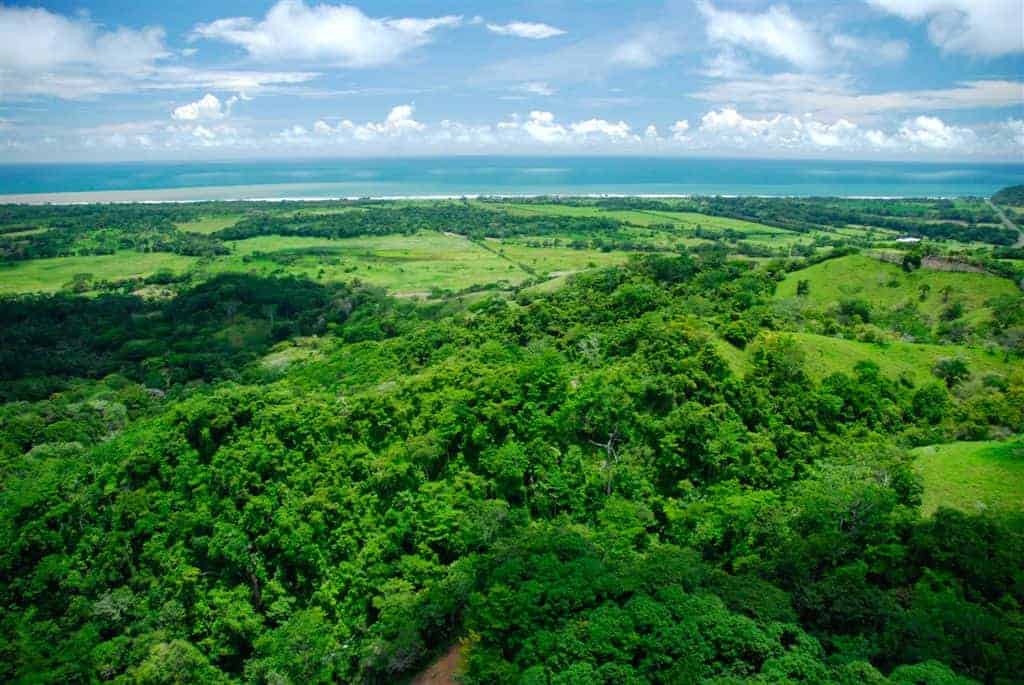The environment minister, the nation’s ombudswoman and the head of the Environmental Tribunal took to the air last week in search of real estate developments along the southern Pacific breaking the law. In a Cessna 206 provided through the environmental group CAVA, the officials flew along the spine of the Fila Costeña coastal mountain range, north of the OsaPeninsula but within the canton of Osa, where environmentalists and officials fear the construction of luxury homes and hotels is causing serious environmental damage.
“The mountains of Osa are bleeding,” José Lino Cháves, head judge for the Environmental Tribunal, said after returning to the capital. “On the Fila, there is a great amount of forest that must be protected. It is the last tropical humid forest on Central America’s Pacific.” The tribunal, accompanied by officials from the Osa municipality and the Environment, Energy and Telecommunications Ministry (MINAET), visited 36 constructions sites, closing five and putting another 16 under investigation, Cháves said.
The majority of the projects closed down or under investigation lack approved environmental impact studies – a requirement for any development or construction, he added. According to a tribunal statement, inspectors found construction projects that exceeded permitted size by as much as 3,000 square meters, lacked even basic municipal construction permits and invaded forested and protected areas, among other violations.
“It is necessary to apply the full weight of the law to control this situation before more serious environmental damage is produced,” said Environment Minister Roberto Dobles. The Fila Costeña mountain range drains half a dozen rivers into the ocean, flowing directly into the Ballena National Marine Park and the Sierpe Térraba National
Wetlands, a delicate ecosystem that includes the largest mangrove forest in the country. Researchers have warned that sediment from the rivers is killing the corals in Ballena and harming the SierpeTérraba National Wetlands, as well as threatening the water supply for dozens of communities that lie along the coast and in the foothills of the Fila Costeña.
“There is a clear violation of the laws going on in Osa, and we are going to speak with the Chief Prosecutor and with the Supreme Court of Justice so they assign an environmental judge exclusively for this area,” said Ombudswoman Lisbeth Quesada.
Quesada said she was going to call on Osa Mayor Alberto Cole to report to her office on the construction permits it has issued. Those permits increased by 200 percent in 2007, and the mayor has defended the development, saying most projects are on former pastureland, not in forested areas.
“We’re better off with construction, including luxury homes, than with pastures,” Cole told The Tico Times earlier this month. “The people who live in Osa are an endangered human species.” The visits were the latest of a series of sweeping, surprise inspections targeting one region at a time across the country, all led by Cháves and his administrative court, which is part of MINAET.
“This is the second time we have gone to Osa,” Cháves said. “The Fila has a very irregular topography. There are roads everywhere, and it is hard to get to all of them.”
The return to Osa follows increasingly vocal concern over the development along the mountain range, including a strongly worded statement from the University of Costa Rica’s University Council, the school’s highest body, calling for a moratorium on construction permits in the area (TT, Oct 10).
Prior to the raids, the tribunal teamed up with The Nature Conservancy (TNC) and CAVU, which specializes in aerial photography and monitoring. “The last few months, targeted overflights with CAVU have been used by TNC and the Tribunal and Osa Conservation area staff to identify and document unsustainable (and often illegal) development projects in the Fila Costeña,” said Michele Gangaware, CAVU’s flight program director. “Last week, a series of flights provided by CAVU gave Minister Dobles, the Environmental Tribunal and members of the press a newfound understanding of the size and scope of the development in the Fila.”
The officials used GPS coordinates to map projects they spotted from the air and followed up with the surprise inspections on the ground, Cháves said. Among those visited was Costa Verde Estates, a development project put under investigation by the tribunal. Representatives of the project, however, insist they have their permits.
“We have never touched a ‘protected area.’ We have all of the permits for the building sites, roads and entrances, as well as the forestry contracts issued by MINAET. No building sites were done in any primary or secondary forest areas. The only parts of the property that have been developed are those that were previously teak plantations,” Kristi Penland, a project representative, told The Tico Times.
She also suggested development has actually improved the area. “In the last 20 years, the northern part of the Osa has gone from bare, overgrazed hillsides that were burned every April filling the skies with smoke to a lush, rarely burned forested zone,” she added. “The change in the environment was brought about by foreign visitors buying out the cattle ranchers and allowing the land to recover.”






